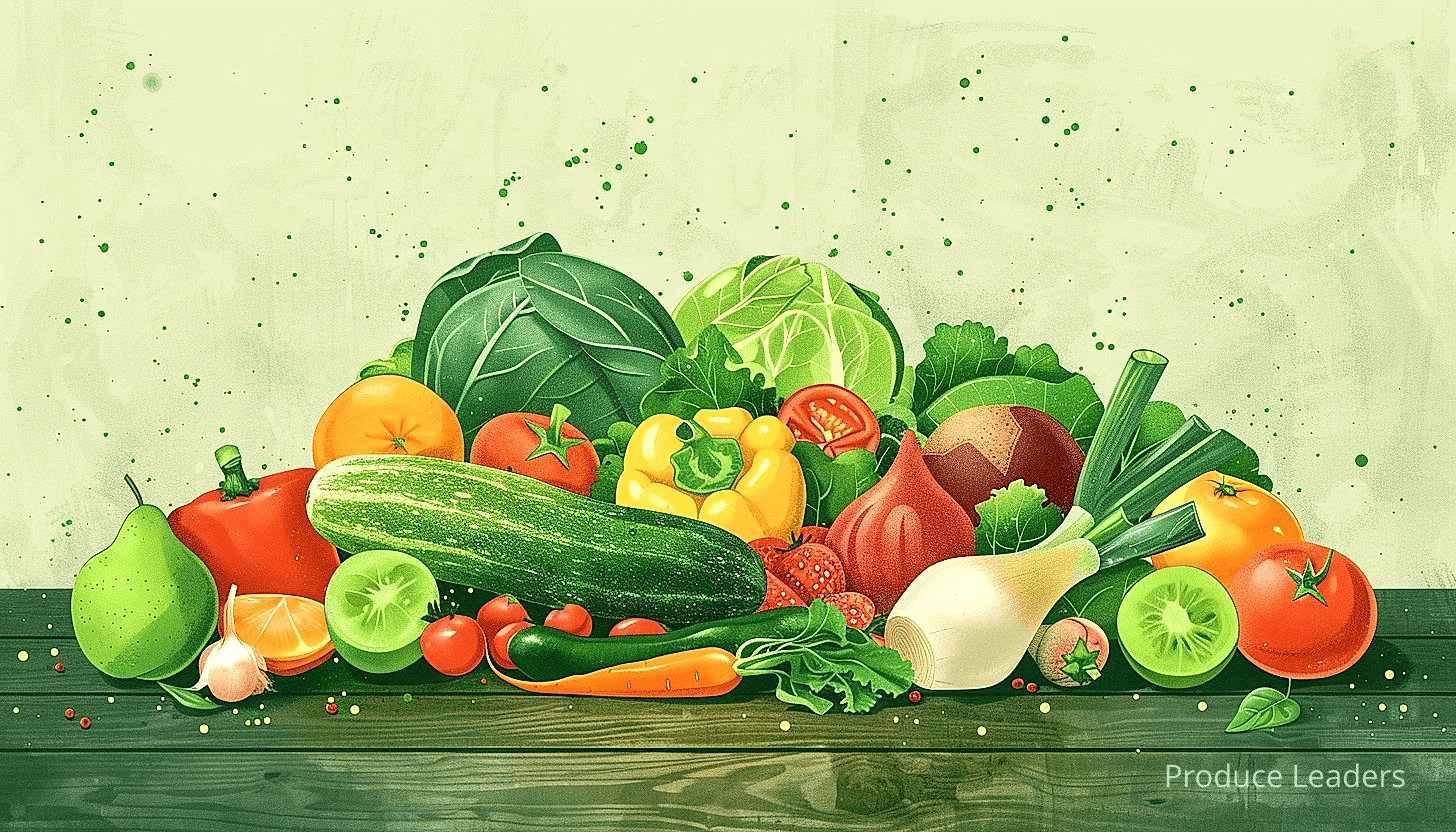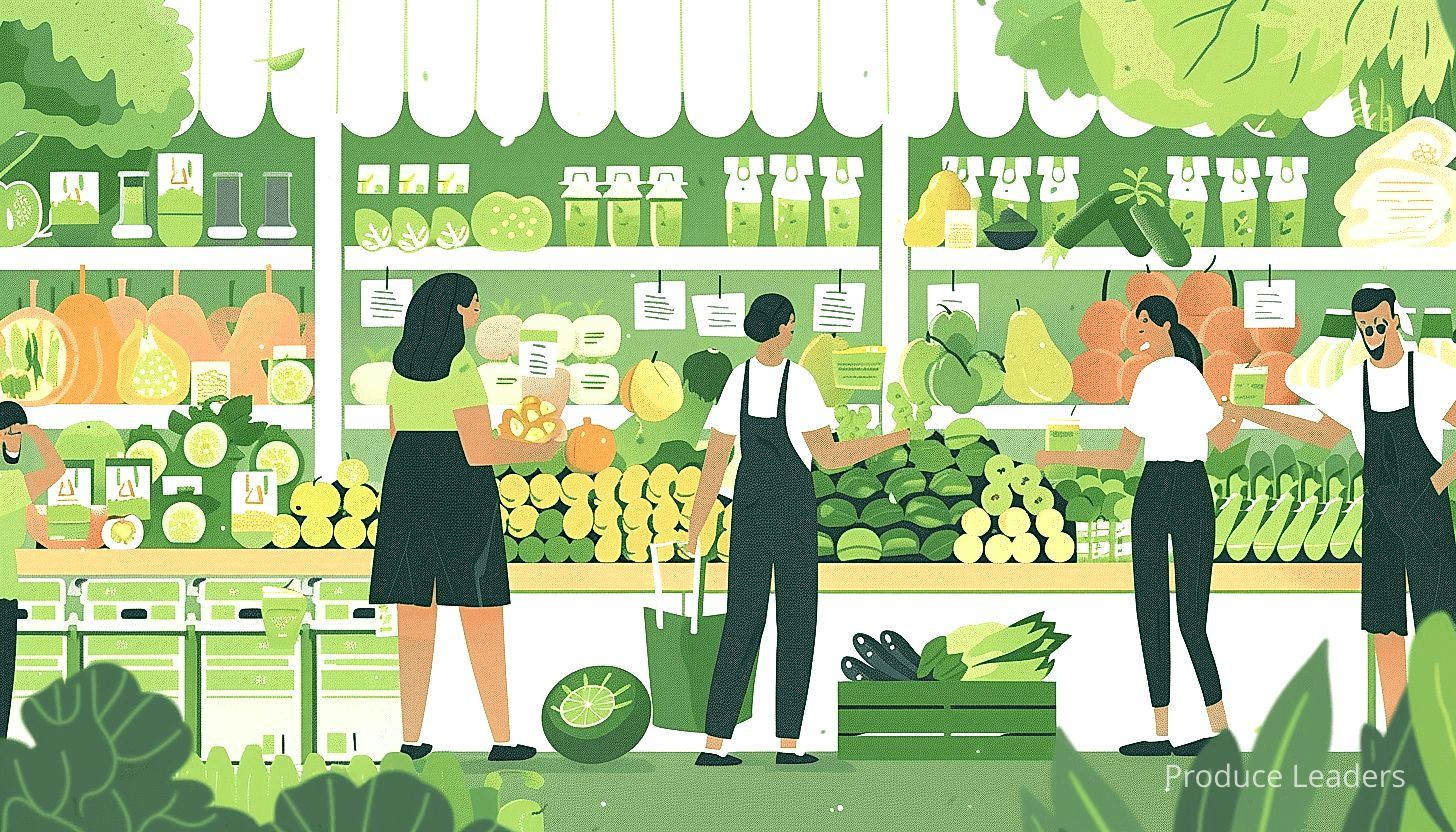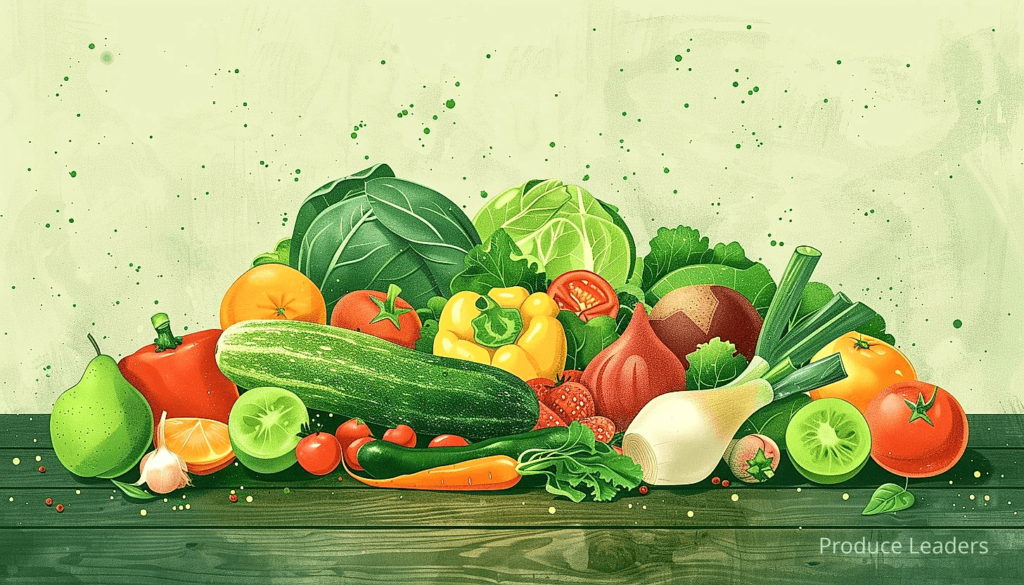Eco-branding enhances fresh produce sales by aligning products with increasing consumer demand for environmentally friendly options.
As consumers become more aware of environmental issues, they are prioritizing products that are sustainably produced and packaged.
Displaying eco-friendly certifications or labeling on fresh produce acts as a powerful marketing tool, catching the attention of environmentally conscious shoppers.
Eco-branded products also benefit from a perceived increase in quality and value, thus justifying potentially higher price points.
Moreover, eco-branding helps companies differentiate their product in a saturated market, gaining a competitive advantage.
By communicating a company’s commitment to environmental issues, eco-branding can foster consumer trust and loyalty, driving repeat sales.
- Eco-branding appeals to consumers who prefer environmentally responsible options.
- Eco-labels significantly boost the sales of fresh produce.
- Perceived quality is amplified through eco-branding tactics.
- Eco-branding can provide a competitive edge in markets.
- Effective eco-branding enhances consumer trust and loyalty.
While eco-branding and its influence on fresh produce sales is a pivotal point, the broader context of its implications extends even further.
If you are curious about how such marketing strategies can induce sustainable consumer behavior, expand your business footprint and contribute towards a green economy, what follows will certainly be of interest.
The sections that lie ahead will also touch upon the regulatory framework for eco-branding, and will discuss strategies for effective eco-branding implementation focusing on striking the right balance between market competitiveness and environmental conservation.
Stay tuned as we dig in into these critically relevant aspects. You won’t want to miss this information as it may pivotally help shape your approach to eco-branding practices.
Contents
What is Eco-Branding?
In Short: Eco-branding is a marketing strategy that emphasizes a product’s environmentally-friendly characteristics, connecting with consumers who increasingly prefer sustainable goods. To promote authenticity, companies must ensure honesty in their claims about environmental impact, aiding their stand-out reputation in the marketplace.
Let’s dive straight into it. Eco-branding is a method that businesses use to leverage environmental awareness to promote their products or services.
Eco-branding involves market strategies that highlight a product’s green attributes. Do you get the picture?
In today’s world, companies are not just entities centered on making profits. They play a crucial role in sorting out social and environmental issues.
For instance, a company can claim that its agricultural procedures are eco-friendly. They could specify their products are free from pesticides or harmful chemicals associated with environmental and health problems.
Now, aren’t you wondering about the impact this has on consumers? The straightforward answer is that consumers increasingly prefer environmentally friendly products. Eco-branded products thus gain an edge in the market.
This includes an array of products, right from organic vegetables to sustainable meat products. However, it’s not just about being eco-friendly; it’s more about the perception created.
Here are some important points that explain this eco-branding phenomenon in the context of fresh produce:
- Organic labels are often considered synonymous with eco-branding.
- Companies that display a clear commitment towards environmental sustainability are more likely to get recognition.
- Raising awareness about environmentally friendly cultivation methods has a significant role in rising sales figures.
- There is no denying that taste and price still play a key role in customers’ decisions. But, the eco-friendly tag has begun to hold its own sway.
Marketing teams work hard to tap into this trend. They design branding strategies that effectively communicate their eco-friendly values to consumers.
This, in turn, creates a trustworthy perception of the product and the company. Can you imagine how powerful that is in today’s marketplace?
It’s not only about promotions anymore; it’s about educating the public. This public is a group eager to make choices beneficial to themselves and their environment.
Let me tell you, something as complex as global warming can be simplified through eco-branding. This isn’t just about making sales but embarking on a much-needed environmental initiative. Isn’t that impressive?
Yet, there’s more to this story. Eco-branding is not a surefire way to success. It’s important to be authentic and maintain honesty in these claims. Greenwashing, or making false claims about a product’s environmental impact, can backfire rather fast.
Consumers are now savvier and have access to a vast expanse of information. Companies that intend to practice eco-branding need to understand this. They must make sure they’re prepared to stand behind their claims.
In the marketplace, you can either stand out or blend in. Eco-branding provides an opportunity for companies to do the former. This method shines a brighter light on their commitment to sustainability.
With the advantages it brings, it’s hard to deny that eco-branding is shaping the future of marketing. But remember, it comes with its own set of challenges, ready to be tackled head-on.
Why Consumers Prefer Eco-Branded Produce?
In Short: Consumers prefer eco-branded produce due to beliefs of superior quality, a desire for transparency in production, and the satisfaction derived from environmental sustainability. This trend is driven by increasing environmental consciousness, self-identity alignment, and social perceptions of eco-branded products as status symbols.
In the current age of increasing awareness about environmental sustainability, it’s no surprise that many consumers are actively seeking eco-branded produce. But why is this the case?
One key factor driving this trend is a simple one – consumers believe that eco-branded products are better for the environment. Isn’t that a good enough reason to buy eco-branded?
It’s not just about the impact on the planet either. Many shoppers are convinced that eco-friendly produce is actually better quality as well. They see these products as cleaner, healthier, and more natural than their non-eco counterparts. Isn’t it always better to opt for quality over quantity?

But let’s pull back for a moment. What does ‘eco-friendly’ actually mean? Well, generally it refers to products that are made in a way that minimizes harm to the environment. Wouldn’t you want that for your food?
However, it’s not enough to simply put a green label on a product and call it ‘eco-friendly’. Smart consumers are increasingly looking for transparency about a product’s eco credentials. They want to know what makes it eco-friendly, how it was grown, and what steps the producer took to minimize environmental harm. Don’t we all deserve the right to know these details?
Before we dig in deeper, here’s a quick rundown of reasons consumers might prefer eco-branded produce:
- An increasing awareness of the importance of sustainability.
- The perception that eco-brands offer superior quality.
- A desire for transparency about production methods.
- The emotional satisfaction derived from making a positive environmental impact.
Moving further, there’s also an important emotional factor at play – the satisfaction of knowing that you’re doing something good for the planet. Choosing an eco-branded apple over a regular one might not seem like much, but it can give consumers a small sense of satisfaction. Who doesn’t want to feel good about their choices?
In addition, consumers who prioritize eco-branded produce are often those who see themselves as environmentally conscious. Would you agree that aligning your purchases with your personal beliefs can solidify your sense of self-identity?
Finally, let’s not forget the influence of social pressures. In certain circles, buying eco-branded products can be seen as a status symbol – a signal to others that you’re more environmentally responsible, health-conscious, or just plain trendy. Isn’t it funny how our purchasing habits can say so much about us?
Let me tell you, there’s clearly a wide range of reasons why consumers might prefer eco-branded produce. Whether it’s out of concern for the environment, a belief in superior quality, or just personal preference, it’s clear that this trend is not going anywhere soon. Are you part of this eco-conscious shift?
Impact of Eco-Labels on Sales
In Short: Eco-labels on fresh produce enhances sales by providing trustworthiness, appealing to environmentally-conscious consumers and positioning the brand as socially responsible. However, these labels must align with genuine sustainable efforts by the business to maintain quality and reputation.
Have you ever considered how the presence of eco-labels on fresh produce can influence consumer buying behavior? Eco-labels aren’t just a beneficial tool for the environment, but can also be a powerful marketing strategy for businesses.
Producers are starting to recognize the significance of eco-labeling, aren’t they? This recognition is partially influenced by the clamor for more sustainable and ethical methods in food production.
Now, let’s take a looks at several ways how eco-labeling can positively impact the sales of fresh produce:
- Firstly, eco-labels provide a sense of trustworthiness and validity. Knowing that a product has been audited or certified instills consumer confidence.
- Secondly, consumers today are more environmentally-conscious. Eco-labels appeal to these individuals, followingly boosting sales.
- Lastly, eco-labeling positions the brand as being socially responsible. A positive brand image can significantly help in increasing sales.
Recognizing these factors, businesses are leveraging eco-labels to promote their products in the market. Can we therefore say that eco-labeling has become a modern marketing weapon?
Yes, because when a business utilizes eco-labels, they’re not just promoting the product. They’re also showcasing their commitment to the environment and global sustainability. This differentiates them from their competitors, wouldn’t it?
Indeed, the power of eco-labeling isn’t limited to its environmental impact. It also has a strong influence on customer perception and purchase decisions. Is it not fascinating how a simple label can stimulate sales?
Eco-labels rely on the impression of being environmentally friendly to boost sales. However, it is essential that businesses implementing these labels operate in a manner that aligns with their claims. Hypocrisy can have a detrimental effect on a brand’s image, wouldn’t it?
Furthermore, producers can’t simply slap on an eco-label and expect instant results. Eco-labeling is most effective when combined with proactive, ongoing sustainability efforts. Consistency is important here, don’t you agree?
Pro Tip: Utilize eco-labels on your products as a powerful marketing strategy to build trust with environmentally-conscious consumers, differentiate your brand, and ultimately boost sales.
While eco-labeling can provide an initial boost to sales, also maintaining quality and practicing sustainable methodologies ensures long-term success. After all, just like trust, reputation also plays a significant role in customer decision-making, doesn’t it?
As we all know, while eco-labeling comes with its unique challenges and obstacles, the potential benefits to both the environment and the bottom line are undeniable. Therefore, producers of fresh produce should consider adopting this strategy moving forward.
Quality Perception and Eco-Branding
In Short: Consumer choices in fresh produce are highly influenced by the perception of quality, which is frequently associated with eco-branded produce, resulting in increased sales. Despite not guaranteeing overnight success, eco-branding requires a holistic approach incorporating all stages of the product journey and syncing with consumer outlook to effectively drive sales and build trust.
Perception of quality is a pivotal factor influencing consumer choices in fresh produce. What does this mean for suppliers and retailers?
Most consumers equate high quality with fresh, organic or sustainably produced goods. Naturally, this perception underpins the way they select their purchases.
Eco-branding enters the picture as an influential strategy. But why is it advantageous?

Marketing studies reveal that eco-branded produce is often perceived as superior in quality. This perception, in turn, prompts increased sales.
Eco-branding, hence, seems to communicate a signal of superior quality to the consumers. This is a phenomenon that suppliers and retailers in the fresh produce realm cannot ignore.
Does leveraging eco-branding guarantee overnight success? Not necessarily.
While eco-branding holds promise, it certainly isn’t a one-size-fits-all solution. However, it has unquestionably paved the way for some remarkable success stories in the fresh produce market.
Let me tell you, what exactly has led to the rise of eco-branding as a potent strategy in marketing fresh produce? Let’s take a closer look.
- Increasing awareness about environmental concerns and food safety
- Consumers’ inclination towards healthy and ethically sourced products
- Emerging regulations and certifications promoting eco-friendly practices
- Development of innovative packaging solutions that reinforce the eco-friendly message
These factors have created an opportune ecosystem for eco-branding to thrive.
One might ask, does eco-branding always translate to increased sales? The key lies in understanding consumer behavior.
Consumers today are diligent and informed. They are eager to understand the story behind what they buy. Hence, simply applying the eco-branding label isn’t sufficient.
Instead, what can deliver results is an integrated eco-branding strategy. The strategy needs to encompass the entire product journey – the sourcing, the process, and the packaging.
Eco-branding, thus, calls for a holistic approach. It’s not just about selling a product, but selling a worldview that syncs with the consumers’ outlook.
Important: Eco-branding seems to communicate a signal of superior quality to consumers, prompting increased sales, and for it to be effectively, it requires a holistic approach, encompassing the entire product journey – the sourcing, the process, and the packaging.
Indeed, eco-branding promises an exciting avenue for fresh produce retailers. However, to see an increase in sales, retailers need to execute the strategy genuinely and meticulously.
Because in the end, what matters is not just how consumers perceive quality, but how much they trust the brand. Wouldn’t you agree?
Eco-Branding in Competitive Markets
In Short: Eco-branding, conveying a company’s commitment to sustainable practices, has become a critical strategy in the fresh produce industry, attracting eco-conscious consumers and improving brand image. Despite challenges such as authentic transparency and implementing sustainable processes, its potential rewards and competitive edge make it a worthwhile pursuit.
It is indisputably true that market competition in the fresh produce industry is fierce.
Consequently, fresh produce companies are in a constant search for innovative ways to set themselves apart from the crowd.
One successful strategy that has emerged is eco-branding.
Let me tell you, why is eco-branding such a powerful tool in this competitive market? Forgive the pun, but let’s dig deeper.
Eco-branding communicates a company’s commitment to environmental sustainability.
In doing so, it appeals to the increasing number of consumers that prioritize green initiatives and sustainable practices.
Let me tell you, is it just a fad or are there real benefits associated with eco-branding?
Let’s break down some of the key advantages in the following list:
- Reinforces a positive brand image to existing and potential customers.
- Improves brand loyalty as consumers align themselves with ethical choices.
- Opens up new marketing avenues through sustainability credentials.
- May lead to desirable business alliances with other eco-friendly companies.
Those are some of the advantages, but what about the challenges?
Indeed, eco-branding doesn’t come without its own set of challenges.
Critical among these is establishing authenticity and transparency.
Consumers today are savvy, and attempts at ‘greenwashing’ can tarnish a company’s reputation.
Another challenge lies in delivering the eco-promise.
Implementing sustainable practices throughout the supply chain is an onerous process, necessitating significant investments and resources.
Let me tell you, can eco-branding provide a competitive edge?
Undeniably, and even more so in the fresh produce market.
In an industry where the products are inherently natural, sustainable practices carry even more weight.
As such, by adopting eco-branding, companies can effectively differentiate themselves, becoming more attractive to eco-conscious consumers and boosting sales.
Pro Tip: Adopting eco-branding in the fresh produce industry can help differentiate your company by appealing to eco-conscious consumers, boosting sales and brand loyalty, despite the challenges of maintaining authenticity, transparency and implementing sustainable practices.
Let me tell you, while investing in eco-branding may entail overcoming challenges, the rewards could be substantial.
After all, isn’t it promising to create a win-win situation, where companies are thriving while contributing positively to the environment?
Enhancing Trust and Loyalty
In Short: Eco-branding is a powerful tool in the fresh produce market, helping to enhance customers’ trust and loyalty by showcasing a commitment to environmentally responsible practices. This strategy, which includes clearly communicating sustainable methods, educating consumers on environmental initiatives, and avoiding harmful chemicals, has been proven to directly boost product sales, demonstrating the potential benefits of aligning with sustainability.
In the world of fresh produce, eco-branding has emerged as a game changer. It is not a mere decoration, but a tool of immense value.
Trust and loyalty, often elusive in today’s consumer cultural, can significantly be boosted through eco-branding. But how exactly does this phenomenon occur?
Eco-branding presents an authentic image of the product or the brand. It is not just a marketing strategy, but conveys an organization’s commitment to sustainability and environmental responsibility.

When customers perceive a product as being authentically ‘green’, they begin to trust the brand more. This perception is often shaped by certain features implicit in the brand’s communication strategy.
What are these features exactly? Allow me to list a few.
- An eco-brand precisely communicates that the product has been produced using environmentally responsible methods.
- There is also an emphasis on the fact that the use of harmful chemicals was avoided during the production process.
- The brand educates consumers on how choosing this particular product supports sustainability initiatives.
- Finally, the brand often showcases ongoing efforts to foster environmental conservation for future generations.
Now, think about it for a moment. Wouldn’t such a brand capture your trust?
The eco-brand doesn’t just sell a product, it sells a positive experience and ideology. Thus, customer loyalty is bound to increase.
When consumers find themselves aligned with the brand’s values, they keep coming back for more. In fact, the loyalty doesn’t just persist; it deepens over time.
In an age where customers are increasingly concerned about the environment, there’s no denying that eco-brands have an edge. They are perceived as responsible, ethical and trustworthy.
Eco-brands foster a unique connection with the consumer that transcends transactional relationships. Would you agree?
And, of course, we cannot ignore the implications of this enhanced trust and loyalty. It directly leads to higher fresh product sales over time.
Important: Eco-branding, which presents an authentic image of a product’s environmental sustainability, can significantly enhance customer trust and loyalty, leading to higher sales over time.
Indeed, eco-branding has proven to be a powerful tool in stimulating relationships of trust and loyalty among customers. This is definitely a testament to its potential in enhancing fresh produce sales.
Therefore, it’s time for more fresh produce brands to evaluate their eco-branding strategy. A closer alignment with sustainability can pay significant dividends in the long run – don’t you think?
Pricing Strategies for Eco-Branded Produce
In Short: Setting the right price for eco-branded produce involves balancing higher prices for the environmental benefit and avoiding customer exploitation. Various strategies such as premium, value-based, penetration, psychological and competitive pricing can be used effectively, coupled with flexible adjustments for market changes and sincere eco-branding strategy.
Finding the right pricing strategy for eco-branded produce can be a challenging task. There is a delicate balance to strike.
Firstly, why is this balance important? Well, the answer lies in understanding the consumers’ perception of value.
Customers are becoming more aware of the negative environmental impact of conventional farming methods. And with this awareness comes a willingness to pay a little more for greener options. Isn’t that a step in the right direction?
Yet, there is a limit. Price your produce too high, and customers might feel like they are being exploited. Price it too low, and the perceived value of your eco-friendly produce might decrease.
Let’s examine an often-adopted strategy: premium pricing. This method emphasizes the higher quality and environmentally-friendly nature of the products. But one might ponder, is this the most effective strategy?
Another approach is the value-based pricing strategy. In this, the product’s price is set according to the value perceived by your target audience. However, how to accurately measure that perception?
These two strategies are not the only options available. In fact, let’s dig in into a few other effective strategies:
- Penetration Pricing: In this strategy, the products are initially priced lower than the competition to gain market share quickly.
- Psychological Pricing: Pleasing the customer’s perception by setting the price slightly lower than a round number (for example, $1.99 instead of $2).
- Competitive Pricing: Setting prices based on those of direct competition.
Now, it’s crucial to note that the key to a successful pricing strategy is flexibility. You should be prepared to adjust your prices according to market changes.
For instance, if there’s a surge in demand for eco-branded produce, you should be ready to increase your prices. Nonetheless, how can one strike a balance between making a profit and keeping the customers happy?
Indeed, this entire game is analogous to walking a tightrope. Every step should be made with deliberate care.
Also, you might be wondering, are there some methods to test the effectiveness of your pricing strategies? Yes, A/B testing is a highly recommended approach. This allows you to test different prices and strategies and find the one that works best.
Greenwash alert! Be cautious in launching your eco-branded produce and avoid over-promising. Honesty in your branding will save you any potential backlash, won’t it?
Beyond pricing, it’s crucial to invest in branding and awareness campaigns. Have you considered the potential of social media in promoting your eco-branded produce?
Adopting a correct pricing strategy, remaining genuine in your branding and listening to your consumers are pivotal. Can you imagine the difference these factors could make in boosting your fresh produce sales?
Relevance of Eco-Branding in Marketing
In Short: Eco-branding is a crucial marketing trend in fresh produce sales, enhancing brand perception and product differentiation while providing a competitive advantage. Consumers’ increased awareness of sustainability and ethical practices means that eco-branding must be backed by authentic, verifiable proof of eco-credentials to build trust and reinforce customer loyalty.
Eco-branding represents a game-changing trend in marketing and is particularly pertinent to the industry of fresh produce sales.
By integrating an environmentally-conscious ethos within a brand, it not only appeals to the growing desire for sustainability, but also gives products a competitive edge in the marketplace.
You may wonder, why has eco-branding increasingly become a significant factor in consumers’ purchasing decisions? Understanding that implication is critical to appreciating its relevancy in marketing.
This trend is rooted in the prevailing societal shift towards sustainability and eco-friendly consumerism. People are becoming more educated and sensitive about the global environmental crisis. Isn’t it astonishing how our choices as consumers can directly impact our planet’s health?

The demand for transparent and ethical practices at every level of production has significantly risen. This heightened awareness compels businesses to firmly anchor their brands to a greater cause. This is where eco-branding reveals its power, playing a fundamental role in shaping consumer perception and market dynamics.
Let’s look at the primary ways eco-branding helps boost sales in the fresh produce sector:
- Product Differentiation: It provides a unique selling proposition that sets the product apart in a crowded market.
- Enhancement of Brand Perception: It elevates the brand’s status in the consumers’ eyes by showcasing the brand’s commitment to sustainability.
- Competitive Advantage: In a marketplace where consumers are willing to pay more for ethically-sourced and environmentally-friendly products, a strong eco-brand can command higher prices and improve profitability.
But just claiming to be eco-friendly isn’t adequate because consumers are more savvy. Wouldn’t you agree it’s essential to provide authentic, verifiable proof of the eco-credentials of a product?
Utilizing third-party certifications and showing complete transparency in production processes can offset this skepticism. Such verification procedures enhance trust in the brand, propagate credibility, and in turn, reinforce customer loyalty.
In a world where consumers are becoming increasingly conscientious about their ecological footprint, aligning a brand towards such values can be immensely beneficial. It’s not merely about driving sales; it’s about building a meaningful brand.
In effect, eco-branding is no longer a nice-to-have, but rather a need-to-have marketing approach. However, it’s important to remember that these benefits come with a commitment to continually uphold and promote sustainable practices. Does it sound like a daunting task? One has to remember, seeking to forge a sustainable world is not merely a marketing strategy – it is indeed the need of the hour!
The Bottom Line
Eco-branding is a powerful tool in the fresh produce sector, promoting both environmental responsibility and positive customer perception.
Consumers are increasingly drawn to eco-branded produce due to growing environmental awareness and the associated health benefits.
Eco-labels have a significant impact on sales, often leading to higher purchase rates due to their perceived credibility and trustworthiness.
The presence of an eco-brand boosts consumers’ perceptions of quality, often associating it with superior taste and nutritional content.
In a highly competitive market, eco-branding helps businesses stand out and differentiates their products from conventional options.
Trust and loyalty are further fostered in consumers by eco-branding due to its alignment with their personal values and concerns for the environment.
Strategic pricing for eco-branded produce must reflect its perceived added value without deterring potential consumers.
With its ability to influence purchase decisions and build customer loyalty, eco-branding is significantly important in marketing fresh produce.




















